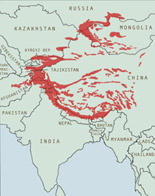Bhutan snow leopards

Paro Dzong fortress and monastery in Bhutan, home of snow leopards. Photo Sibylle Noras.
Bhutan is a small and beautiful Himalayan country. It is a spiritual place with emphasis on “Gross National Happiness “ being as important as the more common economic indicator, standard of living, -“Gross Domestic Product”.
Bhutan’s flora and fauna represents enormous diversity and the spectacular rugged mountains, swift rivers and deep valleys are home to antelope, marmots, blue sheep, tiger, Himalayan musk deer, Tibetan wolves, takins (Bhutan’s national animal) and snow leopards.
Habitat and snow leopard numbers
There is an estimated 10,000 square kilometres of potential snow leopard range in the north of the country. Snow leopards have been confirmed in Jigme Dorje National Park , Wangchuk National Park and Bumdeling Wildlife Sanctuary.
According to recent data the total population of snow leopards in Bhutan is estimated at 100-200. This is a small number and may not be viable in the long term especially if these cats are not able to mingle with snow leopards in other areas to breed.
Threats
The Snow Leopard Network’s 2014 Report, Snow Leopard Survival Strategy identifies the following as the most critical threats to snow leopards in Bhutan.
- Growing Livestock Populations and Intensifying Human- Wildlife Conflict
- Disturbance Related to Cordyceps Collection (a popular fungus growing in high altitude grasslands)
- Climate Change
- Lack of Transboundary Cooperation
Other threats also exist. Bhutan’s mountains have been an excellent habitat for snow leopard in the past. Remote, high and with significant prey species like deer and marmots, snow leopard areas have had minimal human impact. But this has changed with increased village growth and increased livestock numbers especially yaks. Snow leopards are losing habitat. As wild prey decreases snow leopards often attack domestic livestock. Like many other countries where villagers share snow leopard habitat there have been reports of snow leopards killed in retaliation for killing yaks and other livestock. Since 2003 there have been over 100 cases of snow leopards coming in conflict with yak herders.

Park ranger Tenzin Phuntso with a freshly killed Blue sheep in Jigme Dorje National Park Bhutan.Blue sheep are natural wild prey for snow leopards in Bhutan. Photo Tashi Tsering WWF Bhutan.
Bhutan is also close to the Asian markets for wildlife animal parts used in unproven, traditional Chinese medicines (TCM). High prices for animal parts, including snow leopard pelts tempt people to become poachers. Snow leopard numbers have declined. With fewer tigers available for animal parts for TCM the snow leopard has become more of a target as some people believe taking medicines made from snow leopard parts are as effective as tiger medicines.
Conservation in Bhutan
Hunting of snow leopards is prohibited through the Forest and Nature Conservation Act 1995. Killing of a snow leopard can result in a fine of BTN 15,000 (approx. USD 309), which is among the highest fines for killing an animal in Bhutan and approximately twice the annual income of a wildlife warden).
In 2005, World Wildlife Fund (WWF) organized a regional Snow Leopard Action Strategy Workshop in Paro, Bhutan to develop an action plan for snow leopard conservation in this region and to form the Snow Leopard Working Group.
In 2008 WWF began a study of snow leopards in Jigme Dorje National Park to establish snow leopard numbers and the numbers of their prey species. The Snow Leopard Trust (Seattle, USA) was also involved in this work.

Tshewang Wangchuk searching for snow leopards in rugged mountains of Bhutan.
During 2011-2012 camera traps by the WWF have captured over 10,000 images of snow leopards in Wangchuck Centennial Park which adjoins the forests of Sikkim and Arunachal Pradesh which are also snow leopard habitat. The photos from these cameras show that snow leopards are still to be found in this park which connects Jigme Dorji National Park in the west of the country and Bumdeling Wildlife Sanctuary in the east.
WWF also trains anti-poaching squads, educates key officials and trains local staff in conservation of Bhutan wildlife and flora.
Other conservation organisations working in Bhutan include the Snow Leopard Conservancy who are partnering with the Bhutan Foundation to introduce community based education and conservation programs.
Read more about snow leopards in Bhutan here.



